
An aerostat is a lighter-than-air aircraft that gains its lift through the use of a buoyant gas. Aerostats include unpowered balloons and powered airships. A balloon may be free-flying or tethered. The average density of the craft is lower than the density of atmospheric air, because its main component is one or more gasbags, a lightweight skin containing a lifting gas to provide buoyancy, to which other components such as a gondola containing equipment or people are attached. Especially with airships, the gasbags are often protected by an outer envelope.
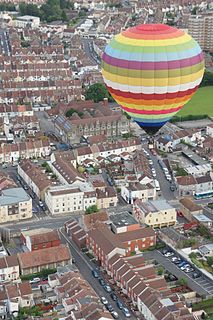
In aeronautics, a balloon is an unpowered aerostat, which remains aloft or floats due to its buoyancy. A balloon may be free, moving with the wind, or tethered to a fixed point. It is distinct from an airship, which is a powered aerostat that can propel itself through the air in a controlled manner.

The Albuquerque International Balloon Fiesta is a yearly hot air balloon festival that takes place in Albuquerque, New Mexico, during early October. The Balloon Fiesta is a nine-day event occurring in the first full week of October, and has over 500 hot air balloons each year far from its humble beginnings of merely 13 balloons in 1972. The event is the largest balloon festival in the world, followed by the Grand Est Mondial Air in France.

A gas balloon is a balloon that rises and floats in the air because it is filled with a gas lighter than air. When not in flight, it is tethered to prevent it from flying away and is sealed at the bottom to prevent the escape of gas. A gas balloon may also be called a Charlière for its inventor, the Frenchman Jacques Charles. Today, familiar gas balloons include large blimps and small latex party balloons. For nearly 200 years, well into the 20th century, manned balloon flight utilized gas balloons before hot-air balloons became dominant. Without power, heat or fuel, untethered flights of gas balloons depended on the skill of the pilot. Gas balloons have greater lift for a given volume, so they do not need to be so large, and they can stay up for much longer than hot air balloons.

A solar balloon is a balloon that gains buoyancy when the air inside is heated by solar radiation, usually with the help of black or dark balloon material. The heated air inside the solar balloon expands and has lower density than the surrounding air. As such, a solar balloon is similar to a hot air balloon. Usage of solar balloons is predominantly in the toy market, although it has been proposed that they be used in the investigation of planet Mars, and some solar balloons are large enough for human flight. A vent at the top can be opened to release hot air for descent and deflation.

A hopper balloon is a small, one-person hot air balloon. Unlike a conventional hot air balloon where people ride inside a basket, there is no basket on a hopper balloon. Instead, the hopper pilot usually sits on a seat or wears a harness similar to a parachute harness. Hoppers are typically flown for recreation. These aircraft are sometimes called "Cloud Hoppers" or "Cloudhoppers." However, these terms formally refer to the products of a particular manufacturer, specifically Lindstrand Balloons. Nonetheless, "Cloudhopper" is used by many people as a genericized trademark, which refers to all craft of this general type. Most hopper balloons have envelopes that range in volume from 14,000 to 35,000 cubic feet and have a maximum flight duration of 1 to 1.5 hours. The two principal commercial balloon manufacturers today offering hopper balloons for sale are Cameron Balloons and Lindstrand Balloons. Most other hopper balloons are experimental aircraft designed and built by amateur constructors.
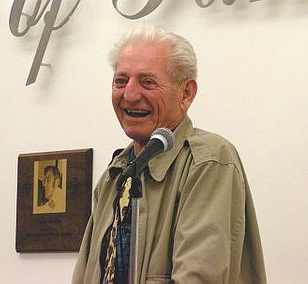
Paul Edward Yost was the American inventor of the modern hot air balloon and is referred to as the "Father of the Modern Day Hot-Air Balloon." He worked for a high-altitude research division of General Mills in the early 1950s when he left to establish Raven Industries in 1956, along with several colleagues from General Mills.

A thermal airship is an airship that generates buoyancy by heating air in a large chamber or envelope. The lower density of interior hot air compared to cool ambient air causes an upward force on the envelope. This is very similar to a hot air balloon, with the notable exception that an airship has a powered means of propulsion, whilst a hot air balloon relies on winds for navigation. An airship that uses steam would also qualify as a thermal airship.

Hot air ballooning is the activity of flying hot air balloons. Attractive aspects of ballooning include the exceptional quiet, the lack of a feeling of movement, and the bird's-eye view. Since the balloon moves with the direction of the winds, the passengers feel absolutely no wind, except for brief periods during the flight when the balloon climbs or descends into air currents of different direction or speed. Hot air ballooning has been recognized by Fédération Aéronautique Internationale (FAI) as the safest air sport in aviation, and fatalities in hot air balloon accidents are rare, according to statistics from the National Transportation Safety Board (NTSB).
Per Lindstrand is a Swedish aeronautical engineer, pilot, adventurer and entrepreneur. He is particularly known for his series of record-breaking trans-oceanic hot air balloon flights and, later, attempts to be the first to fly a Rozière balloon around the Earth – all with British entrepreneur, Sir Richard Branson. He is also the founder of eponymous Lindstrand Balloons hot air balloon manufacturer based in Oswestry, England.
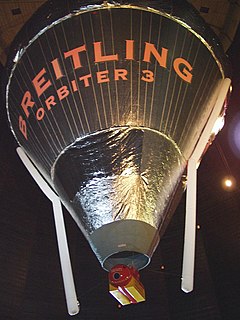
Breitling Orbiter was the name of three different Rozière balloons made by the Bristol based balloon manufacturer Cameron Balloons to circumnavigate the globe, named after the Swiss watchmakers Breitling. The third was successful in March 1999 of making the first nonstop flight around the world by balloon. It was piloted by Bertrand Piccard and Brian Jones.

The history of ballooning, both with hot air and gas, spans many centuries. It includes many firsts, including the first human flight, first flight across the English Channel, first flight in North America, and first aircraft related disaster.

FireFly Balloons is an American hot air balloon manufacturer that started as The Balloon Works (TBW) in 1972 in Statesville, NC. The company is one of the oldest hot air balloon manufacturers in the United States, behind Raven Industries, SEMCO and Piccard Balloons. The origins of the company's designs can be traced to the work of Tracy Barnes in the late 1960s.
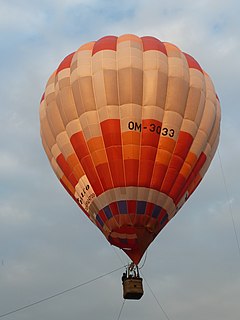
On 13 August 1989, two hot air balloons collided near Alice Springs, Northern Territory, Australia, causing one to crash to the ground, killing thirteen people. It was the world's deadliest ever ballooning disaster until February 2013, when a balloon accident near Luxor, Egypt killed 19 people. As of July 2016, it remains the deadliest ever ballooning accident in Australia, and the third-deadliest worldwide, surpassed only by the Egypt crash and a balloon accident in Texas in 2016 that claimed the lives of 16 people.

On 7 January 2012, a scenic hot air balloon flight from Carterton, New Zealand, collided with a high-voltage power line while attempting to land, causing it to catch fire, disintegrate and crash just north of the town, killing all eleven people on board.
The Cameron D-96 was the first hot air airship, a powered, steerable lighter-than-air craft carrying two or three crew marrying the elongated envelope of an airship with the externally localized heat source of a modern hot air balloon. It was designed and built in the UK and first flown in 1973.

On 26 February 2013, a hot air balloon crashed near Luxor, Egypt, killing 19 out of the 21 people on board. A fire developed in the basket due to a leak in the balloon's gas fuel system, causing the balloon to deflate mid-air and crash to the ground.
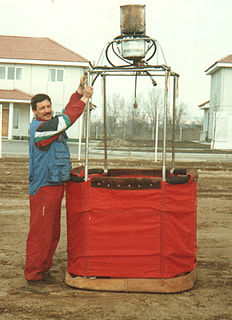
Victor Zagainov was a hot air balloon pilot and astronomer from Kazakhstan. He was the first and only hot air balloon champion of the USSR (1991), Hot Air Balloon champion of the Republic of Kazakhstan (1993), the winner of the International Balloon Grand Prix Todi (Italy) (1993), the champion of the CIS (1996). He organized Grand Prix of Zagainov and was awarded Fédération Aéronautique Internationale (FAI) Diploma for Outstanding Airmanship and the FAI Air Sport Medal in 2003.
In the East German balloon escape in 1979, two families, with eight members in total, escaped the Eastern bloc country of East Germany by crossing the border to West Germany in a homemade hot air balloon. The escape happened at approximately 2:00 a.m. on 16 September 1979. The plot to accomplish this was carried out over a period of one and a half years, including an unsuccessful attempt, three different balloons, and various modifications until the successful escape occurred. One failed crossing alerted the government to the plot, but the police were not able to identify the suspects before their flight to the west.
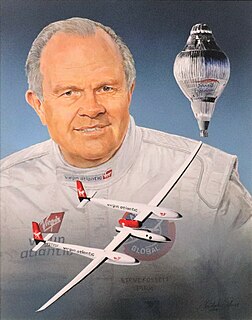
Spirit of Freedom balloon was a Rozière balloon designed and built by Donald Cameron and Tim Cole. In 2002 solo pilot Steve Fossett flew the Spirit of Freedom to become the first successful around-the-world nonstop solo flight in any kind of aircraft. On June 19, 2002, the 10-story-high balloon Spirit of Freedom lifted off from Northam, Western Australia, and landed in Queensland, Australia, on July 3, 2002. The solo flight circumnavigation lasted 13 days, 8 hours, 33 minutes and covered 20,626.48 statute miles (33,195.10 km). They reached speeds of up to 322 kilometers per hour, and flew as high as 10,580 meters.









































